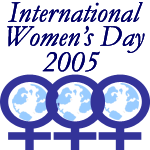




HONG KONG—Ten years after a United Nations global conference in Beijing set targets to improve the lot of women around the world, Asian women still face lower social and economic status, with abuses such as human trafficking, sex slavery, female infanticide, and gender-motivated abortions on the rise in parts of the region.
"There is no tool for development more effective than the empowerment of women," UN Secretary-General Kofi Annan said in a statement to mark International Women's Day on March 8.
"No other policy is as likely to raise economic productivity, or to reduce infant and maternal mortality. No other policy is as sure to improve nutrition and promote health—including the prevention of HIV/AIDS," Annan said.
"Whatever the very real benefits of investing in women, the most important fact remains: women themselves have the right to live in dignity, in freedom from want and freedom from fear. On this International Women’s Day, let us rededicate ourselves to making that a reality," he said.
But a regional survey released Monday showed that women still have lower socio-economic status than men in most Asian countries.
Women in 13 regional economies enjoyed only around 68 percent of the benefits men reaped from tertiary education, pay and conditions, and managerial jobs, the MasterIndex of Women's Advancement found.
Of the 13 markets surveyed, gender inequality was highest in South Korea with a score of 45.5 (where 100 indicates gender equality), followed by Indonesia at 52.5 and Japan at 54.5.
Women in Thailand fared best, with scores of 92.3. China came in at 68.4, Taiwan at 66.4, while Hong Kong scored just 65.1, and Vietnam 63.7, the financial group MasterCard, which ran the survey, said.
"The Asia-Pacific region compares relatively well in the global context in terms of women's advancements in areas like labor-force paticipation and higher education," MasterCard economic adviser Yuwa Hedrick-Wong said. "Progress is, of course, uneven across the region, and much more needs to be done in the future."
Economic inequalities often make women more vulnerable to exploitation, abuse, and the spread of HIV/AIDS, and women in the East Asian region are no exception.
Recent international conferences on human trafficking and disaster relief have reiterated that women in disaster-hit or poverty-stricken regions are far more vulnerable to exploitation than usual.
In China, a fast-growing gap between rich and poor and the dismantling of socialist-style social support systems has contributed to trafficking in women and children and the exploitation of rural women who seek work in richer coastal cities.
This week, China's rubber-stamp parliament, the National People's Congress (NPC), will debate a law banning selective abortions of female fetuses, which together with female infanticide in rural areas has resulted in a massive gender imbalance in the population.
Cultural preference for sons is reflected in China's gender parity figures, which in the 2000 census stood at 119.92 boys to 100 girls, compared with the norm of 100 boys to 105 girls.
Globalization and rapid economic growth have led more women to migrate in search of better opportunities, both globally and in the Asia Pacific region, a recent UN study found. But this factor also rendered them vulnerable to traffickers, the report said.